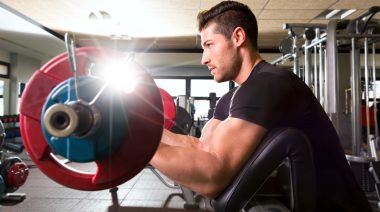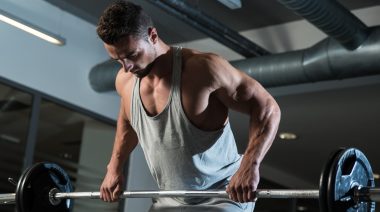When leg day rolls around, many lifters prioritize barbell exercises like squats and Romanian deadlifts. That’s a generally reliable approach for building size and strength, but an aversion to machine exercises can make lower body workouts less effective, and it can make gains harder to come by.
If lifters do incorporate machine-based movements, it’s often basic leg extensions or leg curls and maybe a gratuitous set of calf raises. But one specific machine — a squat variation, in fact — can be the key to unlocking new muscle growth, increased strength, and improved joint health.
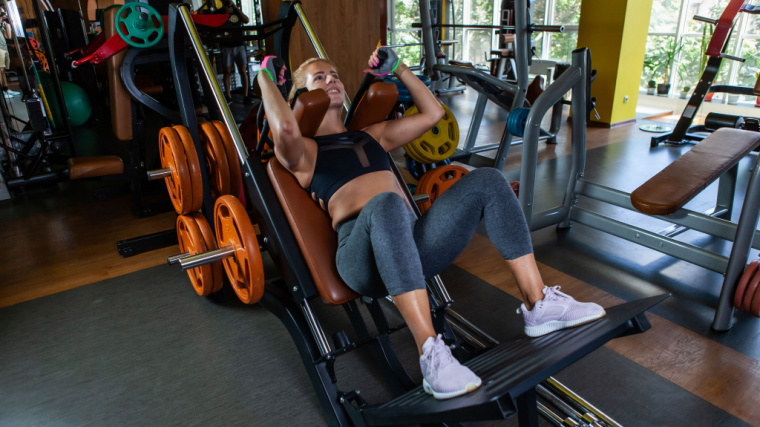
The hack squat is very effective for building the legs and strengthening the knees and hips. It can be a staple in many routines, particularly for those looking to add muscle to their frame. It’s time to learn the ins and outs of this misunderstood machine.
- How to Do the Hack Squat
- Hack Squat Mistakes to Avoid
- Benefits of the Hack Squat
- Muscles Worked by the Hack Squat
- Who Should Do the Hack Squat
- How to Program the Hack Squat
- Hack Squat Variations
- Hack Squat Alternatives
- Frequently Asked Questions
How to Do the Hack Squat
The majority of commercial gyms have at least one hack squat machine, but different equipment manufacturers have slightly different designs. Some are almost completely horizontal, with the lifter lying flat on their back and moving along fixed tracks. Some machines are designed with a full support and shoulder pads on an angled track and foot platform.
Most commonly, however, a seated pad is set up on a 45-degree slant, sometimes called a “linear” or “hip sled” hack squat. An angled foot platform allows your entire lower body to run parallel to the weighted sled, with a seat designed to keep your upper body vertical. There is often a pad supporting the lower to mid-back, no upper back support, and a pair of handles on either side of the seat to hold onto.
Step 1 — Get Your Stance Right
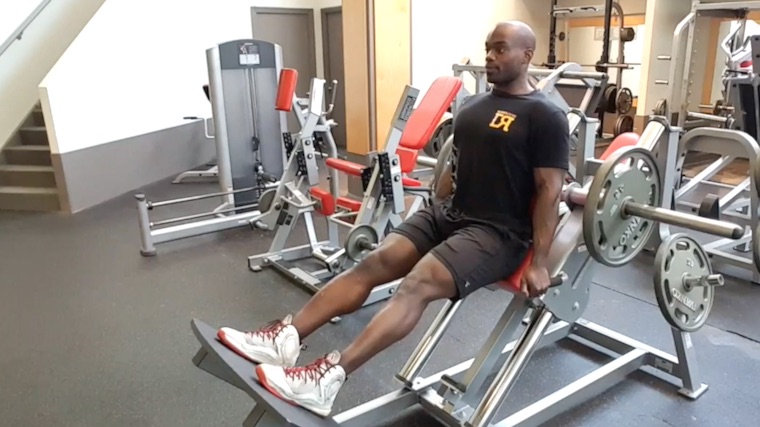
Take a seat and place your feet on the platform. Your lower body flexibility and mobility will influence exactly where you set your feet. The key is to be able to keep your heels flat on the platform as your knees bend fully throughout the entire range of motion.
It’s about finding the sweet spot, which is often around hip-width toward the middle of the platform. Don’t place your feet too high on the platform, too low, too narrow, or too wide — find your Goldilocks stance. What matters most is allowing your knee and ankle joints to achieve a long, pain-free range of motion.
Keep your legs slightly bent without disengaging the safety pins. Sit with your back supported on the pad. Keep your posture upright with your shoulders pulled back.
Form Tip: Try wearing a pair of shoes that add to your lower body support. Sometimes minimalist shoes can create an inadequate base and exacerbate foot issues people have with arch collapse. If it takes switching out of your bare feet or Chuck Taylors and wearing a sturdy pair of lifting shoes while performing a few sets, take the extra step to get the most out of the lift.
Step 2 — Lower Yourself into a Deep Squat
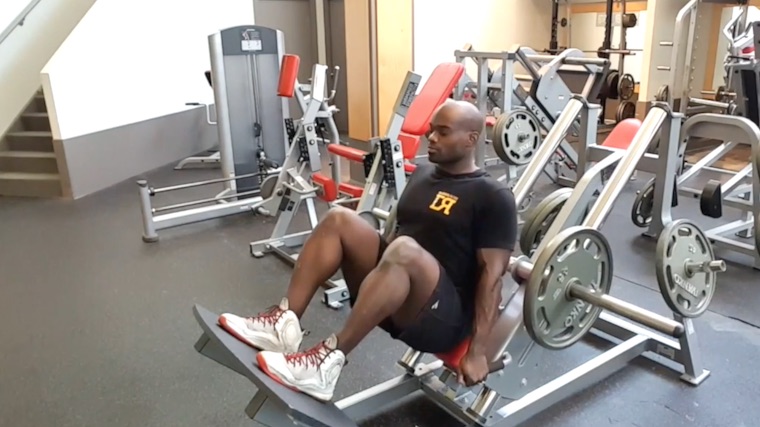
Press through your entire foot and straighten your legs while releasing the safety. Grip the side handles tightly. Maintain good posture and don’t compromise a “proud” chest position.
Slowly lower your body by bending your knees until your upper thigh is roughly 90-degrees to your hip joint — as long as your knees can handle it without pain. Keep your feet flat on the platform and maintain contact between your hips and the pad. Pause briefly in the bottom position.
Form Tip: No matter the specific model of hack squat machine, squeeze the handles tightly throughout the exercise. Keeping a tight grip can improve upper body stability and reinforce a strong posture. (1)
Step 3 — Lift Strong to Lockout
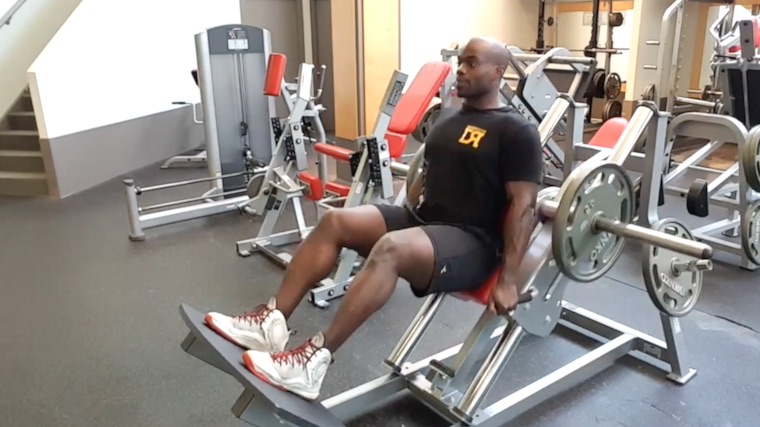
Without bouncing out of the bottom position, straighten your legs by applying strong and steady pressure through both feet. Don’t let your knees cave inward or bow outward.
Press hard into the platform, transferring a powerful leg drive through your hips and into the seat, as you straighten your legs and “stand” back into the top position.
Form Tip: The hack squat is ideal for accumulating mechanical tension, which is very effective for hypertrophy (muscle growth). (2) To keep the working muscles under tension, stop just shy of fully extending or straightening your legs, and keep your knee and hip joints slightly flexed (before lockout).
Hack Squat Mistakes to Avoid
Like most multi-joint movements, not paying attention to details can invite the use of sloppy form and dangerous technique. Troubleshooting this by pinpointing specific mistakes can help you stay ahead of the curve. Here’s how to prevent these follies from taking hold.
Insufficient Range of Motion
Partially bending your knees and performing shallow reps is often due to excessively heavy weight that cannot be lifted through a full range of motion. This reduces muscle activity and short-changes your results. (3)
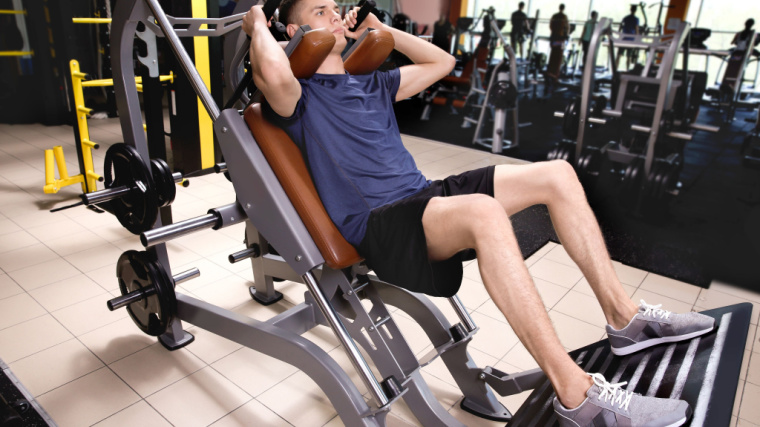
A joint should be trained through its entire available active range of motion. It should also be made strong through that range. (4) There’s no reason why this shouldn’t be the case for basically every load-bearing joint in the body — that’s how you build general physical preparedness and drastically reduce injury risk.
Free weight movements like lunges or front squats involve plenty of total-body stabilizing and muscular coordination, but the hack squat machine lets you pursue a healthy, deep range of motion while loading all involved muscles and distributing stress evenly across joints.
The machine’s support pads drastically reduce the stabilizing and coordination elements, so you can and should focus solely on working through a complete range of motion.
Avoid it: Keep the weight on the lighter side to ensure a full range of motion. Aim to get your upper thigh at a 90-degree angle to your hips on every repetition. When you can do the desired set of reps with that range of motion, it’s time to progress to a heavier load.
Lifting Your Heels
Whether this comes from poor ankle mobility, general negligence, or an attempt to “target the quads” more than simple flat-footed squatting, it’s best to avoid rising onto your toes, especially when you’re learning the hack squat.
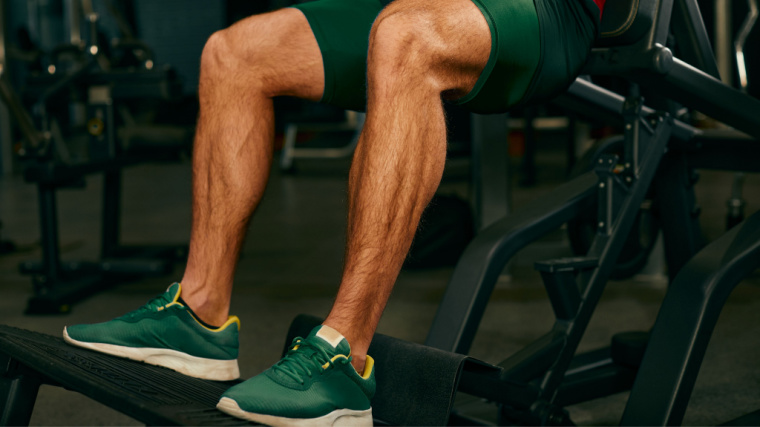
Lifting your heels off of the platform places all of the weight and stress onto the balls of your feet, and will result in plenty of stress also being placed on your knee joints. While some lifters’ knees may be able to handle this extreme stress, it’s still not winning the risk:reward ratio.
Avoid it: Think about elevating the toes slightly off the platform during your descent. This will emphasize your heels staying down. Think about pressing “away” with your feet like you’re about to jump backward, rather than pressing “straight down”, as if you’re about to jump up. This will help keep your full foot involved, and encourage your heels to stay planted.
Slouching with a Weak Core
It may seem like a relatively insignificant detail since the hack squat is a lower body exercise, but your upper body posture plays a role in performance. It’s just like any exercise — the more muscles the entire body can involve in bracing and tightness, the better quality the lift will be as a whole.
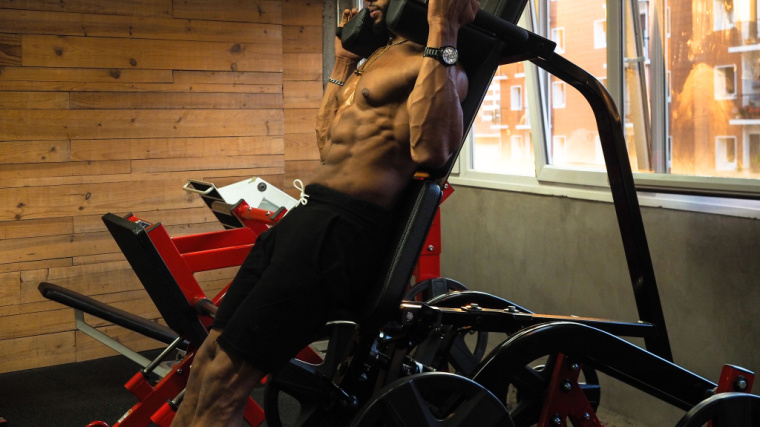
With the hack squat, slouching forward and not keeping an engaged core can result in you “leaking strength” for the lift, which reduces your ability to apply maximum force.
Avoid it: Begin upper body bracing with your grip strength. Hold on to those handles tightly to and tense your upper back by squeezing your shoulder blades together. Maintain that tension throughout the whole set.
Benefits of the Hack Squat
The hack squat can be a key player in your leg workout whether you’re after muscular size or raw strength and power. Just because it’s a machine doesn’t make it less effective than a barbell.
Leg Size
The hack squat removes the need for total-body stabilizing and spatial awareness, and creates a fixed path movement. This allows greater “isolation” to the lower body. While it’s still a multi-joint exercise involving the hips, knees, and ankles, the muscles above the waist are not directly targeted like they would be during back squats, for example.
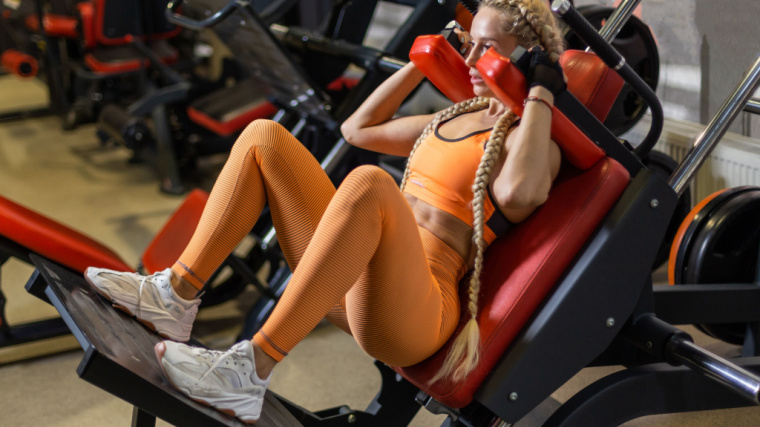
This makes it easier to tap into the muscles of the lower body and stimulate them for hypertrophy (muscle growth). The unique angle of the machine also allows the muscles to be put under constant tension, which further stimulates growth.
Lower Body Strength
Because the hack squat involves the quadriceps, hamstrings, and glutes, it has the potential to be loaded with relatively heavy weights. Your legs can be targeted with decreased strain on the lower back, making the hack squat an effective way to build lower body strength without the lower back wear and tear from barbell squats or deadlifts.
Knee Strengthening
It’s no secret that the knee joint is put under a fair amount of pressure when performing the hack squat, and that’s actually the reason why many lifters avoid the movement altogether. However, for healthy individuals without pre-existing knee issues, this can create beneficial stress on the connective tissues of the knee, and joint health can potentially improve in the long-term.
To make any joint stronger, just like making any muscle stronger, a lifter will have to get comfortable with a bit of discomfort. Improving joint strength requires adding (reasonable) stress to that joint, and using sound technique, appropriate loading, and progressive volume is the most effective path.
Muscles Worked by the Hack Squat
As a squat variation, the hack squat certainly targets your legs. The machine’s path and angle of resistance offer a unique training variety and stimulate the muscles slightly differently than other variations, making it a highly effective movement.
Quadriceps
The quads are the main muscle group hit by the hack squat. This is a group of four muscles on the front of the thigh that attach through one common tendon at the top of the knee. Since they have one common point of attachment, it’s difficult to isolate the quad muscles individually, but the hack squat trains them very effectively as a group.
The quadriceps’ main role is to extend the knee joint (straighten the leg), so achieving a deep knee bend is important to work the muscles through a full range of motion.
Glutes and Hamstrings
The hamstrings and glutes, the entire back half of your upper legs, are relatively less involved during the hack squat. Both muscle groups play a role in hip extension (pulling your lower body backward in line with your torso), which isn’t a significant movement pattern during the hack squat.
The glutes and hamstrings both play a small role in controlling your descent and transitioning out of the bottom position.
Hip Flexors
Your hip flexor muscles, found above your quadriceps on either side of your pelvis, are also involved in the hack squat. They work to bring your thighs closer to your torso, so they are highly activated in the lower part of the range of motion.
Because your legs are set at a fixed angle relative to your torso, your hips flexors are under constant tension because the hack squat keeps your hip joint from fully extending (stretching) throughout the movement.
Who Should Do the Hack Squat
This exercise spans a broader audience than may meet the eye. While it is a relatively specialized machine, it can be used very effectively by lifters with a variety of training goals.
Muscle-Focused Lifters
The hack squat is an effective movement for any lifter who wants to make their legs grow. It’s a staple in many bodybuilders’ quad-focused workouts because it allows the quadriceps to take the majority of training stimulus with minimal strain on the lower back or other supporting muscles.
Lifters who have a hard time isolating their quads with other movements like barbell squats, due to having longer legs, poor leverages, or mobility restrictions, may particularly benefit from the hack squat. There’s no escape from plenty of quad activation with this movement.
Lifters with Back Injuries
The hack squat can be useful for lifters with prior back injuries who want to continue hard leg training. If your spine can no longer handle squatting with a barbell on your back, the hack squat can allow you to keep loading relatively heavy weights with a big compound (multi-joint) squat variation.
Beginners
Beginners can often benefit from the added stability and predictability of the hack squat machine. The movement pattern is pre-determined, so lifters are able to use proper technique more easily. Using the hack squat in conjunction with more challenging movements (like squats and lunges) can be a great way to find results faster and build crucial training confidence.
How to Program the Hack Squat
The hack squat is most often used as a secondary exercise, performed after another compound lift like squats, deadlifts, or even split squats. This allows the hack squat to more thoroughly work the target muscles without affecting the stability requirements of free weight exercises.
Moderate Weight, Moderate Repetition
For optimal muscle-building, the best course of action is to chase reps into the double-digits. Three to five sets of 10 or more reps. Aim to accumulate relatively high training volume on this exercise — plenty of sets and reps — to maximize the hypertrophy signal.(5)
Moderate to Heavy Weight, Lower Repetition
If you decide to make the hack squat your primary movement of the workout, you can increase the weight used and lower the reps, since your central nervous system will have a little bit more in the tank when you’re completely fresh. Four to five sets of five to eight reps will let you move heavier weights while still maintaining perfect form.
Hack Squat Variations
The hack squat machine is one specific exercise, but the hack squat movement is, itself, a more general squat variation. There are several options to get the strength-building and joint health benefits if you don’t have access to a genuine hack squat machine.
Landmine Hack Squat
The landmine hack gives your ankles a more open angle to move through because your feet are flat on the ground rather than angled. That means happier knees and even more range of motion. Having the weight set in a landmine unit also allows you to make minor lateral adjustments to find the perfect groove.
Turning around and having your back against the weight plates allows you to find the perfect degree of “body lean” and the right foot position, similar to squatting with a Smith machine, without the confines of a completely fixed path. This combines to deliver a great pump, since you’re constantly using your quads to push back against the weight and maintain your body’s angle.
Barbell Hack Squat
Technically speaking, this is the original hack squat. Named after George Hackenschmidt, a European strongman from the very early 20th century, this movement is done by placing a barbell just behind your heels, squatting down, grabbing the bar, and lifting it up.
Elevating your heels with a block or weight plate changes the angle of your ankles, similar to wearing weightlifting shoes, and encourages a deep squat position. The barbell also acts as a counterbalance and allows an upright torso, which reduces lower back strain.
Reverse Hack Squat
This is a simple variation of the hack squat done on machines with full back supports and shoulder pads. By facing into the machine, you can allow your hips to move backwards, similar to a barbell back squat, which can increase hamstring and glute activity.
However, you must maintain a neutral spine. Hinging excessively at the hips and creating a more horizontal torso angle can drastically increase stress on your lower back. Some lifters may also find that their knees move forward and hit the machine’s rails, forcing them to keep their knees and lower legs at an awkward or inefficient angle.
Hack Squat Alternatives
Without a hack squat machine or effective variations, there are several effective machine-based movement to build lower body size and strength with reduced joint strain.
Leg Press
This may be the most common hack squat alternative since the two movements share many similarities. Both exercises keep your feet on a platform, which places your knees as the prime moving joint rather than your hips, and affects muscle recruitment. Both movements also require your hips to remain flexed due to your lower body’s position relative to your upper body.
The leg press may be a suitable option for people who experience too much knee stress from hack squats, since the foot platform is now moving toward your body as opposed to your body moving toward the foot platform. This subtle change can make a big difference for managing knee stress. (6)
Smith Machine Squat
The Smith machine squat is another popular and effective alternative to the hack squat (and a relatively popular alternative to barbell squatting, too).
One key benefit to the Smith machine is the ability to set your feet well in front of the bar, ensuring a vertical shin angle. Because this position does not allow your knees to move forward, there’s extremely little stress on your knee joints (which also means little joint-strengthening benefit). However, the muscular stress on the quadriceps is significantly increased.
FAQs
Should I always squat deep?
Generally, you’ll stimulate better overall results — more muscle growth, more strength, and more mobility — by working in the maximum range of motion you can achieve in the working joints. If you’re physically unable to squat extremely deep, squat to your current best depth.
With consistency and effort, your range of motion will improve right along with your muscle gains and your weights. The only time to avoid squatting deep is when you make a conscious decision to adjust the range of motion to apply a specific training method.
For example, some lifters might deliberately perform short range of motion squats to use heavier weights as a short-term overload phase, before returning to full range of motion training. That’s a far cry from accidentally loading too much weight on the bar and shaving reps high to massage your ego.
Time to Hack It
The hack squat is a movement that is for everyone and not for everyone at the same time. Rather than vilifying certain exercises based on what the pro-barbell “gym bros” say or what the functional-based “research” may purport with insufficient context, it’s better to remember that everyone isn’t built the same. Your individual mileage may vary with any exercise, and it’s up to you to apply the power of trial and error.
Hack squats can provide significant benefits when it comes to quad strengthening and muscle-building. The movement caters to both the beginning lifter looking to find his groove and the advanced lifter who’s putting the finishing touches on their lower body physique. Give the lift a fair try and discover how it works for you.
References
- Gontijo, L. B., Pereira, P. D., Neves, C. D., Santos, A. P., Machado, D., & Bastos, V. H. (2012). Evaluation of strength and irradiated movement pattern resulting from trunk motions of the proprioceptive neuromuscular facilitation. Rehabilitation research and practice, 2012, 281937. https://doi.org/10.1155/2012/281937
- Schoenfeld B. J. (2010). The mechanisms of muscle hypertrophy and their application to resistance training. Journal of strength and conditioning research, 24(10), 2857–2872. https://doi.org/10.1519/JSC.0b013e3181e840f3
- Kubo, K., Ikebukuro, T., & Yata, H. (2019). Effects of squat training with different depths on lower limb muscle volumes. European journal of applied physiology, 119(9), 1933–1942. https://doi.org/10.1007/s00421-019-04181-y
- Pallarés, JG, Hernández-Belmonte, A, Martínez-Cava, A, Vetrovsky, T, Steffl, M, Courel-Ibáñez, J. Effects of range of motion on resistance training adaptations: A systematic review and meta-analysis. Scand J Med Sci Sports. 2021; 31: 1866– 1881. https://doi.org/10.1111/sms.14006
- Mangine, G. T., Hoffman, J. R., Gonzalez, A. M., Townsend, J. R., Wells, A. J., Jajtner, A. R., Beyer, K. S., Boone, C. H., Miramonti, A. A., Wang, R., LaMonica, M. B., Fukuda, D. H., Ratamess, N. A., & Stout, J. R. (2015). The effect of training volume and intensity on improvements in muscular strength and size in resistance-trained men. Physiological reports, 3(8), e12472. https://doi.org/10.14814/phy2.12472
- Escamilla, R. F., Fleisig, G. S., Zheng, N., Lander, J. E., Barrentine, S. W., Andrews, J. R., Bergemann, B. W., & Moorman, C. T., 3rd (2001). Effects of technique variations on knee biomechanics during the squat and leg press. Medicine and science in sports and exercise, 33(9), 1552–1566. https://doi.org/10.1097/00005768-200109000-00020
Featured Image: kristian ezcurra / Shutterstock



